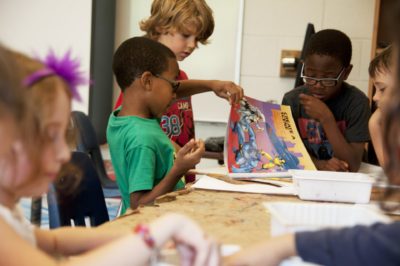As a teacher, it is critical to your longevity and success that you have a solid understanding of and embrace culturally responsive teaching. Allowing students to be their authentic selves in the classroom will support your lesson planning, classroom management practices, assessment of student learning, and instructional methods (Lew & Nelson, 2016).
What is Culturally Responsive Teaching?
Culturally responsive teaching asks educators to include the culture of students in the classroom experience. That experience includes instruction, student management, classroom design, parent engagement, and more. When students are put at the center of instruction, it’s only natural that their cultures and perspectives be the starting point for everything related to their education. But far too often students’ backgrounds are not considered in the learning process.
Culturally responsive teaching is not simply valuing the culture of students. In the past, teachers who took oversimplified views of culturally responsive teaching led them to reject it, and as a result, student achievement did not improve (Lew & Nelsen, 2016). Culturally responsive teaching describes the importance of valuing and using students’ home languages and cultures in the classroom during instruction to build a bridge between home and school (Walter, 2018; Mackay & Strickland, 2018; Harmon, 2012).

Culturally responsive teachers include students’ in the creation of knowledge in the classroom using their personal and cultural strengths as assets where prior knowledge, student interest, and language are used in learning activities (Walter, 2018; Mackay & Strickland, 2018; Rhodes, 2017; Bassey, 2016; Harmon, 2012). Teachers must develop a socio-cultural consciousness that acknowledges and accepts that the way students think, behave, and identify are heavily influenced by race, class, and language. Culturally responsive teaching obliges teachers to see differences as indications of diversity that they honor and respect in the classroom and grow from due to interactions with students (Walter, 2018; Mackay & Strickland, 2018).
Why is Culturally Responsive Teaching Necessary?
Research has shown how important and influential students’ culture and language diversity are to their motivation to learn and self-empowerment. Students do have a sense of self like all human beings do. If teachers fail to recognize the importance of students’ culture to their success, they are not fully addressing their needs. How can you teach and inspire someone you don’t know? (Walter, 2018; Mackay & Strickland, 2018; Bassey, 2016; Gay 2002),
As the student population in the United States continues to grow more diverse, the teaching force continues to be dominated by white women, making culturally responsive teaching all the more important. Teachers unfamiliar with this pedagogy are at a disadvantage when building relationships with students and authentically engaging them. In the 21st century, teachers must invest in culturally responsive teaching as standard professional practice.
You may think that you are doing everything now to help your students achieve including putting in lots of hours planning lessons and engaging activities. But you might be missing the one thing that is most important to that process—your students cultural and language backgrounds. To begin, let’s make sure you have a clear understanding of what culturally responsive teaching is and what it looks like in practice.
1. Learn Students’ Assets
All students come to the classroom with multiple levels of knowledge and skills that often go unnoticed. Teachers must take deliberate action to discover these talents. These tips should help.
Start by identifying your strengths. Knowing your students’ strengths is an important first step. Sometimes these strengths are known such as a student who is a talented musician or star athlete. But other times, it is not obvious and requires some effort to discover such as a student who assists elders in his community or a student who speaks a different home language. You may ask your students directly to identify their strengths and/or record your perspective. This student asset profile provides detailed background on a student’s strengths and identity capital.

When you are considering your students’ strengths, make sure you include their culture and cultural values and their interests. A student’s self-image and self-concept are developed from their funds of knowledge. That knowledge includes students’ families, communities, their languages, and beliefs. A word of caution: Don’t get too obtrusive with students and their families. Be respectful of their privacy and allow them to share what they want. Don’t make this assignment mandatory, and be sure to follow the policies of your school district.
2. Create Supportive Environments
Design welcoming classrooms. Developing positive student-teacher relationships is the key to students’ academic success. When students feel respected and trust the authority in the classroom, they want to work with and for that person. Their effort and “mental stretch” increase under these circumstances. So, learn students’ names and take an interest in their lives. Make a point to attend events like games and performances where you can interact with students and families in an informal and nonthreatening manner.
Make sure your classroom walls are rich and reflect the students you serve. Include a variety of student work that shows improvement and culturally appropriate figures and references. Check materials for diversity in ethnicity, income, language, and other factors. Don’t use materials that show and/or support stereotypes. Your classroom should be a socially respectful and welcoming space. Students should feel free to be their authentic selves.
3. Review Your Curriculum
Embrace high expectations. Begin with the idea that all students can achieve. Promote your students’ intellectual abilities. Make assignments challenging but not frustrating. The right balance of rigor and relevance will help students stretch their minds to learn new skills and concepts. Inquiry and project-based learning allow students to showcase multiple talents on real-world topics that are engaging.
Design lessons that frequently check for students’ understanding and allow time for reteaching if needed. You can spend more time in the future on advanced lessons when you make sure that students have the foundational knowledge they need. Resist the temptation to move on when students demonstrate they have not grasped the content taught. Evaluate your process and try again.
These three practices are the basis for culturally responsive teaching. They will require consistent practice and study. Learn as much as you can about them, and your students will appreciate the learning and social experiences you provide them. As you embrace this way of thinking and being, you will inspire your colleagues to adopt your professional practices. Good teachers are always looking for ways to improve and grow.
If you want to prepare to teach the students of the 21st century, you must be able to successfully work with students from a variety of backgrounds. As our society continues to become more diverse, it will be increasingly important that teachers work from a culturally responsive framework. Don’t wait for your school district to offer culturally responsive training. Take the chance to learn more today.
